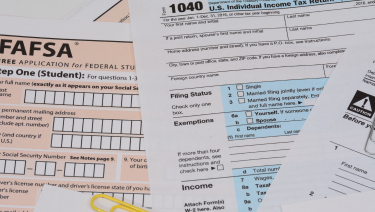
Have a senior? All students in Texas must submit a financial aid application to graduate. Every year, billions of financial aid dollars go unclaimed. And in Texas, students miss out on roughly $300 million in grants (free money) each year by simply not enrolling in college. Texas’ financial aid application graduation requirement gives students an extra push to get these funds and pursue education or training after high school.
Families play an important role in the financial aid process. Not only do students benefit from motivation at home, but many students will need to report parental information on their application.
While applying for financial aid can seem confusing, we’ve gathered some tools and resources to help you through the process. Keep reading to find out how you can best support your student this school year.
Want to better understand how you can support your student this school year? Keep reading to learn:
- About Texas’ financial aid application graduation requirement
- How financial aid helps students
- How to help your student prepare for the application
- Where to get more support
- How to help your student with next steps
Note: When available, we will provide links to documents and resources in both English and Spanish. When translations are not available, or to view links in other languages, consider using a Google Chrome browser and use the translate function. You can also download the Orientación para familias | Caja de herramientas de ayuda financiera para familias to view this as a printable document in Spanish.
|
Understand Texas’ financial aid application graduation requirement Texas Education Code states that students must take one of the following actions to graduate:
|
 |
|
Who should opt out? Families can choose to decline the graduation requirement by submitting a signed opt-out form to their student's school counselor. The form is also available in Spanish. This decision may be made based on personal circumstances and a student does not have to disclose their reason for opting out to their school counselor, or on the form. Your student’s school counselor can help answer questions, address your concerns, and provide guidance regarding this graduation requirement. Opting out does not mean that students can never apply for aid. Students who submit an opt-out form can still complete and submit financial aid applications if they change their minds. |
|
Understand how financial aid helps students. Financial aid is money to help pay for college or training after high school. By submitting the FAFSA or the TASFA, students can get financial aid for the upcoming school year. So even if your student isn’t sure about attending college now, completing an application leaves the door open for this decision later in the year. The financial aid application process can be confusing, and some families may not be sure if completing an application is the right choice for their student. Some families may even be nervous about completing an application that requires sensitive personal information. Check out this helpful resource on Debunking Financial Aid Myths in English or in Spanish to learn the truth about these applications so that you can make the best decision for your student. |
  |
|
Availability of aid Free aid Understanding the Lingo Long-term impact on student goals |
|
Help your student prepare for the application. As your student gets ready to complete a financial aid application, they may need your support in the following areas:
|
  |
|
Figuring out which application to complete Students will submit one of the following applications to apply for financial aid:
*Note: Parental citizenship status does not impact a student’s eligibility for financial aid.
When applying for financial aid, students are considered either dependent or independent. Financial aid dependency is not the same as IRS/tax dependency. Dependent students must report parent income information on their application. Here, “parent” only refers to biological or adoptive parents. The following resources can help you figure out your student’s dependency status and which parent (if any) to report on their financial aid application:
Completing the FAFSA or TASFA is much easier if you have the information you need to complete the form. Students and parents of dependent students may need the following to complete their application:
See the Financial Aid Application Checklist in English or in Spanish for a list of materials needed to complete the application. Encourage your student to connect with the college’s financial aid office about any extra documentation they may need from students. Resource spotlight: Watch Federal Student Aid’s How to Create an Account and Username (FSA ID) for StudentAid.gov to learn how to create an FSA ID or review this Instrucciones para sacaruna FSA ID. Hint: Students should use a personal email address for any financial aid or college accounts. Students will lose their district-assigned email addresses after they graduate high school.
Financial aid is offered in annual cycles that run from July 1 to June 30 of the following year. Students should complete an application for the year they are requesting financial aid, and not the current academic year. The FAFSA and TASFA are available October 1 each year. This is the earliest date that a student can complete and submit their application to apply for aid during the upcoming school year. Financial aid is often awarded on a first-come, first-served basis, so encourage your student to apply as early as possible after October 1. Help your student keep track of the following financial aid deadlines:
*Note: The Texas Higher Education Coordinating Board has updated the 2025-26 state priority deadline from January 15 to February 15, 2025 for the 2025–2026 application year. Keep in mind that students need to apply for financial aid every year they’re in school. Visit Federal Student Aid to learn more about when to apply for financial aid in English or in Spanish. Resource Spotlight: Your student can receive free virtual advising support via text message! The Texas Higher Education Coordinating Board developed a chatbot named ADVi – short for advisor – to provide on-demand support to Texas students to help ensure that they receive the information they need to access higher education. When students sign up to receive messages from ADVi, they get:
Currently, ADVi only sends outgoing text messages in English. However, students can ask ADVi to respond to questions in a different language by using #language. If students are looking to chat in Spanish, they can also ask for a human by using #followup and ADVi will connect you with a Spanish-speaking advisor.
Everyone makes mistakes. But when it comes to your student’s financial aid application, making a mistake could cost them. Check out these helpful videos from Federal Student Aid to answer some common questions and help you avoid mistakes on your student's FAFSA.
|
|
Know where to get additional support. You aren’t the only person who can help your student complete a financial aid application. Ask your student’s school counselor about financial aid events or other opportunities for support. Some schools host campus-wide events on nights or weekends. Others have financial aid “office hours” during the school day. Your student may also be able to work on their application during class. Remind your student what information they’ll need if this is the case. |
  |
|
Before meeting with a school counselor or other financial aid advisor, preview the application so you better understand where you and your student need help.
Resource Spotlight: The amount of information out there can be overwhelming. Designed for parents, Tomorrow Ready Texas, provides comprehensive information to help your child become and remain financially responsible. It helps you understand how you and your child can save and pay for college, with an included focus on financial aid and scholarships. |
|
Help your student with next steps Submitting a financial aid application is only the first step to getting money for college or training after high school. Learn how to support your student in what comes next. |
  |
Big takeaway: Encourage students to check any communication portals frequently. This includes their email, their FSA account, any college application portals they’ve created, and regular postal mail. These steps might look different for students completing the TASFA. Encourage your student to contact the colleges they’re applying to if they have questions or concerns about applying, receiving, or maintaining eligibility for financial aid. |
_______________________________________________________________________________________________________________________________________________
Resource Library
Explore the following resources to better support your student in completing and submitting a financial aid application this school year.
General resources
|
Resources to support completing and submitting the FAFSA
|
Resources to support completing and submitting the TASFA
|
Resources to support analyzing financial aid offers
|